Kimberly’s Crabs in Charleston, South Carolina and a Recipe for Crab Cakes with a Spicy Mustard Sauce
Much of the success can be attributed to this fireball who has an infectious smile, cracks jokes, and laughs heartily. Kimberly is incredibly knowledgeable about the waters in South Carolina, the environment where she goes crabbing, and about the varieties of crabs that exist in those waters.
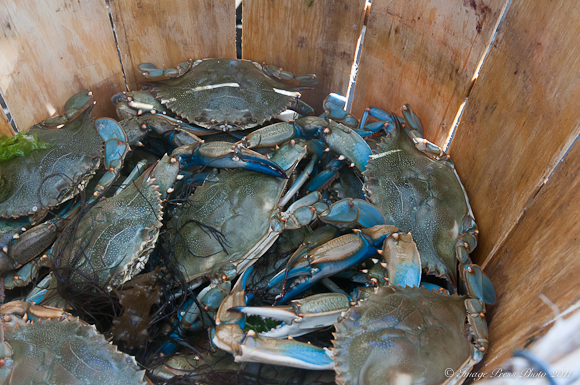
Lots of Blue Crabs!
Kimberly was not always working on a boat. In fact, at one point she had a career in Interventional Radiology at Roper Hospital in Charleston. She decided after several years of working in radiology that she was ready to work for herself and do something completely different. She wanted to be outdoors and on the water, which she loves.
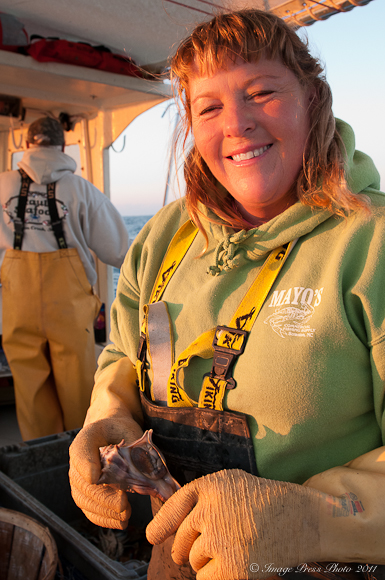
We found some Conch that day.
The recent trend toward using fresh and local catches right off the boat has definitely had a positive impact on her business. There has been a renaissance in using local ingredients. More people are interested in purchasing and eating Lowcountry local foods as opposed to imported foods, especially seafood.
Crabbing is a year-round business, except for one month in the winter when it is incredibly cold. It will also slow down in the summer, which is when Kimberly and Bobby like to take a quick break or vacation.
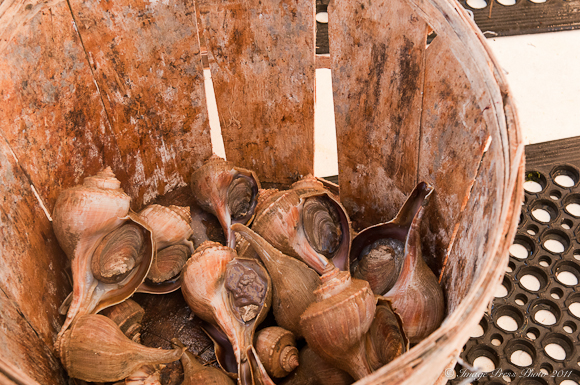
Can I interest you in some Conch Fritters or Chowder?
Kimberly and Bobby have 190 Blue Crab pots which they will visit almost daily most times of the year. They also have special pots for Soft-Shell crabbing. They harvest Blue Crabs, Soft-Shell Crabs, Stone Crab Claws, and some Conch. We also picked up a few Horseshoe Crabs, Spider Crabs, and some really strange-looking unmentionable ocean creatures along the way which were promptly tossed back into the deep dark waters. Ewww…
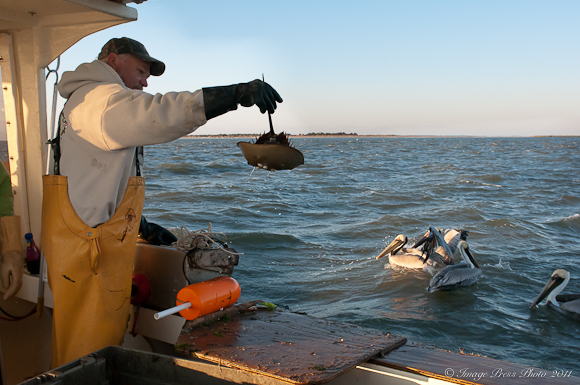
Bobby with a Horseshoe Crab
Did you know that Stone Crabs (“Stonies” as Kimberly calls them) are harvested just for their claws (which have to measure at least 2 3/4 inches before you can take them by law)? One of the claws (which meets those standards) is snapped off in a proper manner so that when they are thrown back into the harbor that claw will grow back again within a year. Who knew?
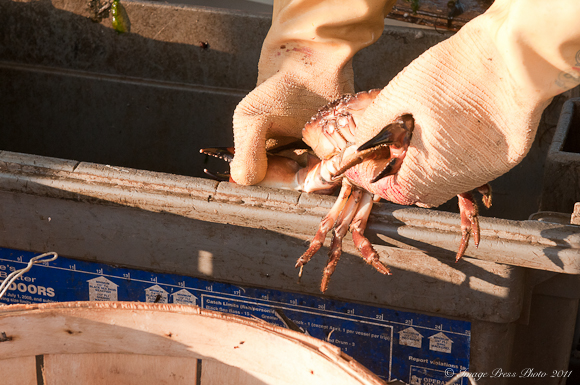
The Stone Crab Claw has to be a certain length before you remove it.
Soft-shell crabs (another crab that is very popular this time of year) are the result of a crab that has recently molted. If they happen to catch a crab that appears to be in the early stages of molting, Kimberly will keep it and it will go into a tank at their home until it actually sheds its hard shell. If it is a small “Peeler Crab,” then it goes back into the ocean until it is perhaps picked up next year.

Unloading the Day’s Catch back at the docks.
Kimberly kept pulling up “Jimmies” in some of the pots. Jimmies are male crabs. During soft-shell crab season (which is now), they will do something called Jimmy Potting where they take the large male crabs and use them as bait instead of fish. These two or three large Jimmies are placed in the upstairs section of the crab pot.
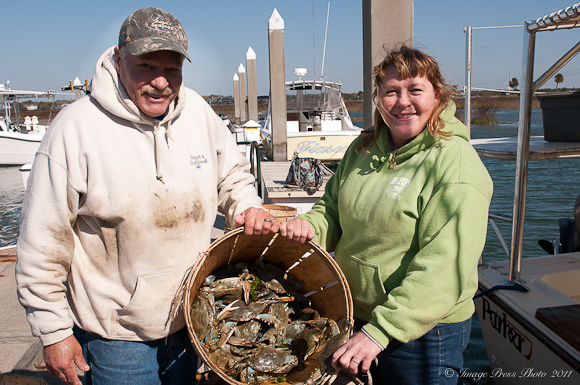
Bobby and Kimberly with their crabs!
The female crabs who did not get their chance to mate in the Fall apparently build up a strong mating urge over the Winter and are attracted by the encaged males. The females willingly enter these pots since the Jimmies are emitting sexually attractive pheromones. There can be as many as thirty female Peelers that will enter the pot from just having two or three Jimmies as bait. Of course, I would tell these girls those odds aren’t so hot, but who knows…
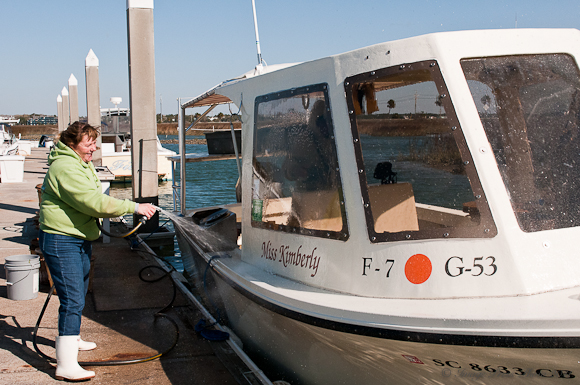
Kimberly is very particular about keeping her boat clean.

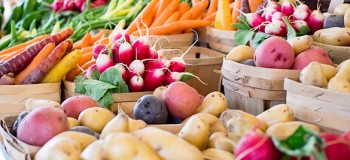
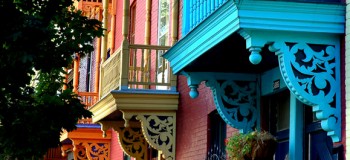
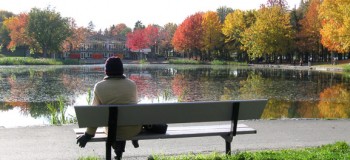



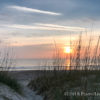








What an awesome experience, love the videos, those were really good. What a living she has, good for her.
Love this crab cake recipe, sounds really good and I can’t wait to try with your mustard recipe too.
Thanks for sharing, see you again real soon.
What an adventure! Ouch, I knew that the claws of stone crabs are snapped off, but at least they are thrown back to grow more so we can have more delicious crab cakes! What kind of crab meat did you use for your crab cakes? On the west coast, Dungeness is very popular – and, like you, I like crab cakes that are mostly crabmeat, just a few seasonings and enough bread crumbs (or crackers) to bind them, the less other stuff the better!
My favorite On the Road post thus far! What an adventure, and honor being invited to experience this remarkable business. I love stories of people who are doiing what they love, especially women! I’m a huge fan of soft-shell crabs, and crab cakes, but getting the crabs fresh off the crab boat is the way to go!
what a fun trip, beside the early morning, lol Kimberly passions really shine through, she’s lovely..thank you for sharing this great post with us and your crab cakes look amazing!!
sweetlife
happy weekend!
Hi, I bet you have a fun trip. I wish I was there. Love the pics and the recipe. Thanks for sharing!
Christine
Gwen, I love crabcakes….but they don’t love me! For you folks that are allergic to seafood, I feel your pain! I modified Kim O’Donnel’s Crab Cake recipe for Meatless Monday, and it came out pretty good. Here’s the link
http://www.friendsdriftinn.com/recipes/chickpea-crab-cakes.html
Coincidentaly, My sisters, 4 of them will be heading to Charleston TODAY for our “sister’s trip, ” which we do each time one of us turns 50. I can not make it..but I sent the link!!
Hi Ya’ll,
What a great time we had on the boat, and so glad you came! the story was great and the photos were awesome.
I took part in the 4th Chef’s Potluck Sunday at Middleton Place with the soft shell crabs. I was paired with FIG. We went through 225 soft shell sammies in about an hour! All the fair was “Locavore” and 10 restaurants and farms took part for Lowcountry Local First Event.
Happy Easter!
Kimberly